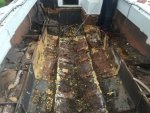peacekeeper6
Senior Chief Petty Officer
- Joined
- Apr 25, 2005
- Messages
- 765
So as I dig out my stringers I really wanted to go with a composite material and was sold on the Coosa but the price is astronomical for my size boat. I bought 3/4 inch marine plywood for about 110 dollars a sheet, I figure if I did the whole boat in marine grade I'll spend roughly 16-20 sheets for 110 a sheet coming out to roughly 1760 on the low end and 2200 for the high side. Coosa for the same amount of material is triple that number. So Coosa is out of the question and honestly I think I can find a composite for what the Marine Grade is going to cost, if not a bit more.
I found Nida-Core honeycomb which I assume can be used as a good core as long as I laminate with fiberglass. (http://www.merrittsupply.com/product...lain-h8pp.aspx) Am I correct in assuming that this is the correct item I need to replace the stringers and transom in my boat as long as its laminated with 1708? This seems like the most cost effective solution but you still have to measure, cut, tab, scarf the pieces together and on a 35 foot boat that could be quite a project in itself.
I then found multiple pouring compounds (Arjay, Seacast, Carbon Core, Nida-Bond) that seem like great alternatives and I can pour everything at one time (transom and stringers together) they range from around 130.00 - 205.00 per pail. If I do the math correct and do a 1 for 1 thickness replacement (1.5inch for the transom 1 inch for the stringers) then I should need roughly 30 pails (for that quantity price goes to roughly 100 per 5 gallon pail) which is 3000.00 bucks. It seems like for ease of use this seems like a middle of the road route for ease and a composite material.
All in all am I missing something here? Can I do a 1 for 1 replacement with the ceramic pourable compound? I am assuming because I cut my stringers out expecting to redo in wood that I will have to re-laminate the pourable anyway or at least tab it to the hull. I am not asking for differences on the products them self (unless you JUST CANNOT use a certain product for stringers as well as the transom).
i included a picture of the grid system before they were completely cut out, but all stringers and bulk heads have about 1 -3 inches of material left that is still tabbed to the hull. Of course if I decide to use wood or a coring material than I would definitely grind these little tabs out. My inner stringer is 24inches high at the highest point, the outter stringers are roughly 17inches high at the highest point. Both stringers run about 288 inches from transom to bow.
I found Nida-Core honeycomb which I assume can be used as a good core as long as I laminate with fiberglass. (http://www.merrittsupply.com/product...lain-h8pp.aspx) Am I correct in assuming that this is the correct item I need to replace the stringers and transom in my boat as long as its laminated with 1708? This seems like the most cost effective solution but you still have to measure, cut, tab, scarf the pieces together and on a 35 foot boat that could be quite a project in itself.
I then found multiple pouring compounds (Arjay, Seacast, Carbon Core, Nida-Bond) that seem like great alternatives and I can pour everything at one time (transom and stringers together) they range from around 130.00 - 205.00 per pail. If I do the math correct and do a 1 for 1 thickness replacement (1.5inch for the transom 1 inch for the stringers) then I should need roughly 30 pails (for that quantity price goes to roughly 100 per 5 gallon pail) which is 3000.00 bucks. It seems like for ease of use this seems like a middle of the road route for ease and a composite material.
All in all am I missing something here? Can I do a 1 for 1 replacement with the ceramic pourable compound? I am assuming because I cut my stringers out expecting to redo in wood that I will have to re-laminate the pourable anyway or at least tab it to the hull. I am not asking for differences on the products them self (unless you JUST CANNOT use a certain product for stringers as well as the transom).
i included a picture of the grid system before they were completely cut out, but all stringers and bulk heads have about 1 -3 inches of material left that is still tabbed to the hull. Of course if I decide to use wood or a coring material than I would definitely grind these little tabs out. My inner stringer is 24inches high at the highest point, the outter stringers are roughly 17inches high at the highest point. Both stringers run about 288 inches from transom to bow.




















